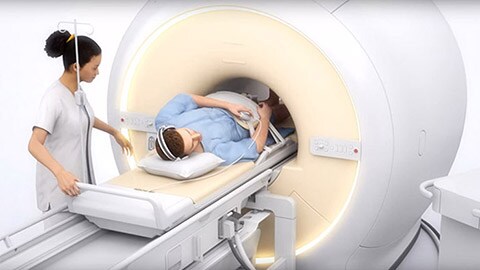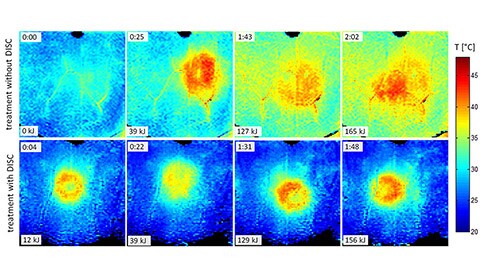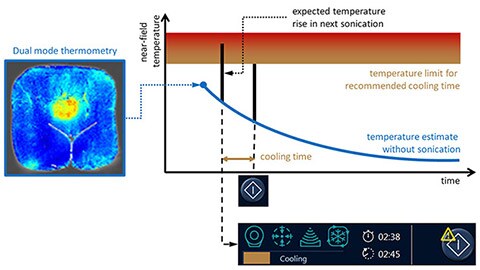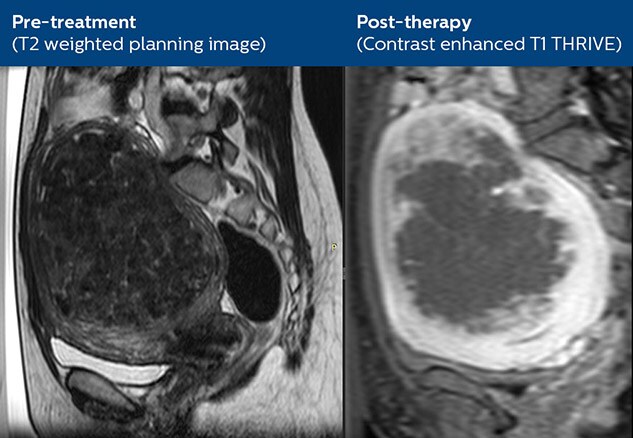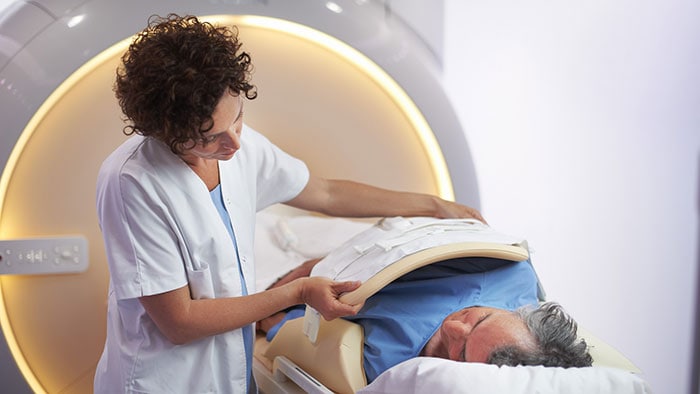MR-guided high intensity focused ultrasound (MR-HIFU) represents a non-invasive treatment alternative for women affected by uterine fibroids, with a much shorter recovery time than surgical treatment. Two innovations were recently introduced to the Philips Sonalleve MR-HIFU system: Direct Skin Cooling (DISC) and Dual Mode Thermometry (DMT). These technologies help increase tissue ablation efficiency and reduce treatment times.
Non-invasive alternative with faster recovery
The conventional treatment for uterine fibroids is surgery: hysterectomy or myomectomy. These sometimes require weeks of recovery. MR-HIFU can be delivered as outpatient procedure, has fewer side effects, and allows women to be almost fully recovered within days. Uterine fibroid ablation is currently the most mature application of MR-HIFU. Treatment consists of several cycles of sonication and cooling, delivered by the HIFU system that is integrated in the Sonalleve patient table. During sonication, the ultrasound energy beam passes through the skin and soft tissue and ablates the focus area by heating it, leaving the skin and intermediate tissue unharmed. This kind of non-invasive alternative to conventional treatment options is highly desired by patients. Or, as Prof. M. van den Bosch, interventional radiologist at the University Medical Center in Utrecht, the Netherlands, said:
The most important thing is that patients want the procedure. I think that is a major push for our program. We have patients who ask for the procedure; they don’t want surgery, they want a non-invasive or minimally invasive procedure.”
Improved temperature management for a more efficient workflow
Tissue ablation speeds for uterine fibroids have traditionally been rather low, taxing patients and care teams and preventing the MR system to be used to bring in diagnostic revenue at that time. The main limiting factor has been the long cooling times needed to prevent undesired heating of the skin and subcutaneous tissues, known as near-field heating. The degree of near-field heating varies from patient to patient, forcing medical professionals to choose cooling times conservatively, often unnecessarily lengthening the procedure.
The introduction of DISC and DMT attempts to overcome this problem from two angles. The DISC device actively cools near-field tissues during treatment by circulating cooled water between the two membranes forming the patient contact. This allows for longer sonication cycles and shorter cooling periods. DMT is a more accurate temperature measurement method, providing more exact estimates of the cooling times necessary before the next sonication can safely be started.
More efficient use of time during treatments: better for patients, better for hospitals
The DISC and DMT innovations have shown encouraging results. Overall, the treatments show improved workflow and a clear reduction in the skin and fat tissue temperatures. In an increasing portion of treatments, sonications have proceeded at a faster pace compared to before installation of DISC and DMT. The frequency at which patients stop sonications due to the sensation of skin heating has been greatly reduced. Adding MR-HIFU to the treatment options not only offers an effective and less invasive procedure for uterine fibroids patients, it also helps with patient recruitment for other departments. For some of the women specifically seeking out an institute for MR-HIFU treatment, the conventional surgical options or uterine embolization are better suited. These women can be referred internally.
The future of MR-HIFU
The technology behind MR-HIFU has the potential to treat a wide variety of solid tumors. Treatment of uterine fibroids is merely the most mature application. In an earlier edition of Hot Spot, we covered the use of MR-HIFU for bone metastases. Several other oncology applications are currently being developed, such as prostate cancer treatment with MR-HIFU.
For more information
Download the white paper on MR-HIFU treatment for uterine fibroids for analyses and case studies. To find out more about the fast, precise, and effective treatment Sonalleve can provide for your patients with uterine fibroids, go to: https://www.philips.com/sonalleve. The Philips Sonalleve MR-HIFU therapy system or all of its applications are not for sale in certain countries. To determine availability in your area, please contact your local Philips representative.
